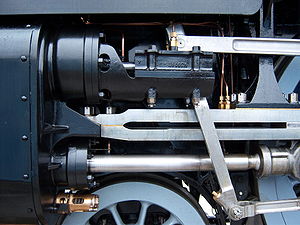The cylinder is the power-producing element of the steam engine powering a steam locomotive. The cylinder is made pressure-tight with end covers and a piston; a valve distributes the steam to the ends of the cylinder. Cylinders were initially cast iron, but later made of steel. The cylinder casting includes other features such as (in the case of Stephenson's Rocket) valve ports and mounting feet.[1] The last big American locomotives incorporated the cylinders as part of huge one-piece steel castings that were the main frame of the locomotive.[2] Renewable wearing surfaces were needed inside the cylinders and provided by cast-iron bushings.

The way the valve controlled the steam entering and leaving the cylinder was known as steam distribution and shown by the shape of the indicator diagram. What happened to the steam inside the cylinder was assessed separately from what happened in the boiler and how much friction the moving machinery had to cope with. This assessment was known as "engine performance" or "cylinder performance". The cylinder performance, together with the boiler and machinery performance, established the efficiency of the complete locomotive. The pressure of the steam in the cylinder was measured as the piston moved and the power moving the piston was calculated and known as cylinder power. The forces produced in the cylinder moved the train but were also damaging to the structure which held the cylinders in place. Bolted joints came loose, cylinder castings and frames cracked and reduced the availability of the locomotive.
Cylinders may be arranged in several different ways.
On early locomotives, such as Puffing Billy, the cylinders were often set vertically and the motion was transmitted through beams, as in a beam engine.
The next stage, for example Stephenson's Rocket, was to drive the wheels directly from steeply inclined cylinders placed at the back of the locomotive. Direct drive became the standard arrangement, but the cylinders were moved to the front and placed either horizontal or nearly horizontal.
The front-mounted cylinders could be placed either inside (between the frames) or outside. Examples of each are:
In the 19th and early 20th centuries, inside cylinders were widely used in the United Kingdom, but outside cylinders were more common in Continental Europe and the United States due to their larger loading gauge. From about 1920, outside cylinders became more common in the UK but many inside-cylinder engines continued to be built. Inside cylinders give a more stable ride with less yaw or "nosing", but access for maintenance is more difficult. Some designers used inside cylinders for aesthetic reasons.
The demand for more power led to the development of engines with three cylinders (two outside and one inside) or four cylinders (two outside and two inside). Examples:
On a two-cylinder engine the cranks, whether inside or outside, are set at 90 degrees. As the cylinders are double-acting (i.e. fed with steam alternately at each end) this gives four impulses per revolution and ensures that there are no dead centres.
On a three-cylinder engine, two arrangements are possible:
Two arrangements are also possible on a four-cylinder engine:
The valve chestsorsteam chests which contain the slide valvesorpiston valves may be located in various positions.
If the cylinders are small, the valve chests may be located between the cylinders. For larger cylinders the valve chests are usually on top of the cylinders but, in early locomotives, they were sometimes underneath the cylinders.
The valve chests are usually on top of the cylinders but, in older locomotives, the valve chests were sometimes located alongside the cylinders and inserted through slots in the frames. This meant that, while the cylinders were outside, the valves were inside and could be driven by inside valve gear.
There are many variations in the location of the valve gear. In British practice, inside valve gear is usually of the Stephenson type while outside valve gear is usually of the Walschaerts type. However, this is not a rigid rule and most types of valve gear are capable of being used either inside or outside. Joy valve gear was once popular, e.g. on the LNWR G Class.
On inside-cylinder engines the valve gear is nearly always inside (between the frames), e.g. LMS Fowler Class 3F.
On some locomotives the valve gear is located outside the frames, e.g. Italian State Railways Class 640.
On engines with outside cylinders there are three possible variations:
There are three common variations:
There are three common variations:
There are many other variations, e.g. geared steam locomotives which may have only one cylinder. The only conventional steam locomotive with one cylinder that is known is the Nielson One-Cylinder Locomotive.[3]